United States Army
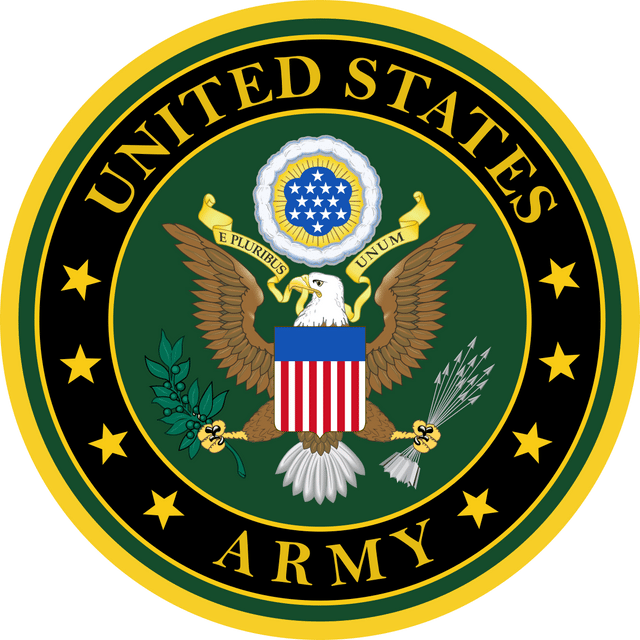
United States Army

| United States Army | |
|---|---|
| Founded | 14 June 1775 (1775-06-14) (244 years, 3 months)[2][3] (as the Continental Army) |
| Country | |
| Type | Army |
| Role | Land warfare |
| Size | 476,000 Regular Army personnel (2017)[4] 343,000 Army National Guard personnel (2017) 199,000 Army Reserve personnel (2017) 1,018,000 total uniformed personnel (2017) 330,000 civilian personnel 4,406 manned aircraft[5] |
| Part of | U.S. Department of Defense
|
| Headquarters | The Pentagon Arlington County, Virginia, U.S. |
| Motto(s) | "This We'll Defend" |
| Colors | Black, gold and white[6][7] |
| March | "The Army Goes Rolling Along"Play |
| Mascot(s) | RADAR The Mule |
| Anniversaries | Army Birthday: 14 June |
| Equipment | List of U.S. Army equipment |
| Engagements | See list
|
| Website | Army.mil [182] |
| Commanders | |
| Commander-in-Chief | President Donald Trump |
| Secretary of Defense | Mark Esper[9] |
| Secretary of the Army | Ryan McCarthy[10] |
| Chief of Staff | GEN James C. McConville[11] |
| Vice Chief of Staff | GEN Joseph M. Martin[12] |
| Sergeant Major of the Army | SMA Michael A. Grinston[13] |
| Insignia | |
| Flag (1956–present) | |
| Emblem of the U.S. Department of the Army |  |
| Logo (2001–present) |  |
| Seal of the U.S. Department of the Army |  |
| Field flag (1962–present) |  |
The United States Army (USA) is the land warfare service branch of the United States Armed Forces. It is one of the seven uniformed services of the United States, and is designated as the Army of the United States in the United States Constitution.[14] As the oldest and most senior branch of the U.S. military in order of precedence,[15] the modern U.S. Army has its roots in the Continental Army, which was formed (14 June 1775) to fight the American Revolutionary War (1775–1783)—before the United States of America was established as a country.[16] After the Revolutionary War, the Congress of the Confederation created the United States Army on 3 June 1784 to replace the disbanded Continental Army.[17][18] The United States Army considers itself descended from the Continental Army, and dates its institutional inception from the origin of that armed force in 1775.[16]
As a uniformed military service, the U.S. Army is part of the Department of the Army, which is one of the three military departments of the Department of Defense. The U.S. Army is headed by a civilian senior appointed civil servant, the secretary of the Army (SECARMY) and by a chief military officer, the chief of staff of the Army (CSA) who is also a member of the Joint Chiefs of Staff. It is the largest military branch, and in the fiscal year 2017, the projected end strength for the Regular Army (USA) was 476,000 soldiers; the Army National Guard (ARNG) had 343,000 soldiers and the United States Army Reserve (USAR) had 199,000 soldiers; the combined-component strength of the U.S. Army was 1,018,000 soldiers.[4] As a branch of the armed forces, the mission of the U.S. Army is "to fight and win our Nation's wars, by providing prompt, sustained, land dominance, across the full range of military operations and the spectrum of conflict, in support of combatant commanders".[19] The branch participates in conflicts worldwide and is the major ground-based offensive and defensive force of the United States.
| United States Army | |
|---|---|
| Founded | 14 June 1775 (1775-06-14) (244 years, 3 months)[2][3] (as the Continental Army) |
| Country | |
| Type | Army |
| Role | Land warfare |
| Size | 476,000 Regular Army personnel (2017)[4] 343,000 Army National Guard personnel (2017) 199,000 Army Reserve personnel (2017) 1,018,000 total uniformed personnel (2017) 330,000 civilian personnel 4,406 manned aircraft[5] |
| Part of | U.S. Department of Defense
|
| Headquarters | The Pentagon Arlington County, Virginia, U.S. |
| Motto(s) | "This We'll Defend" |
| Colors | Black, gold and white[6][7] |
| March | "The Army Goes Rolling Along"Play |
| Mascot(s) | RADAR The Mule |
| Anniversaries | Army Birthday: 14 June |
| Equipment | List of U.S. Army equipment |
| Engagements | See list
|
| Website | Army.mil [182] |
| Commanders | |
| Commander-in-Chief | President Donald Trump |
| Secretary of Defense | Mark Esper[9] |
| Secretary of the Army | Ryan McCarthy[10] |
| Chief of Staff | GEN James C. McConville[11] |
| Vice Chief of Staff | GEN Joseph M. Martin[12] |
| Sergeant Major of the Army | SMA Michael A. Grinston[13] |
| Insignia | |
| Flag (1956–present) | |
| Emblem of the U.S. Department of the Army |  |
| Logo (2001–present) |  |
| Seal of the U.S. Department of the Army |  |
| Field flag (1962–present) |  |
Mission
The United States Army serves as the land-based branch of the U.S. Armed Forces. Section 3062 of Title 10, U.S. Code [183] defines the purpose of the army as:[20][21]
Preserving the peace and security and providing for the defense of the United States, the Commonwealths and possessions and any areas occupied by the United States
Supporting the national policies
Implementing the national objectives
Overcoming any nations responsible for aggressive acts that imperil the peace and security of the United States
In 2018, the Army Strategy 2018 articulated an eight-point addendum to the Army Vision for 2028.[22] While the Army Mission remains constant, the Army Strategy builds upon the Army's Brigade Modernization by adding focus to Corps and Division-level echelons.[22] Modernization, reform for high-intensity conflict, and Joint multi-domain operations are added to the strategy, to be completed by 2028.[22]
History
Origins
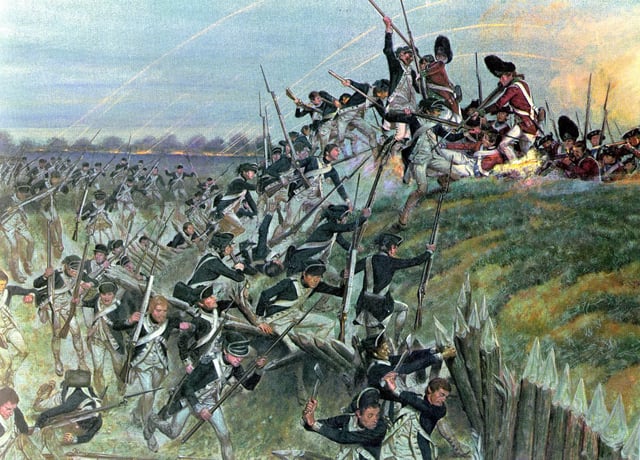
Storming of Redoubt No. 10 in the Siege of Yorktown during the American Revolutionary War prompted the British government to begin negotiations, resulting in the Treaty of Paris and British recognition of the United States of America.
The Continental Army was created on 14 June 1775 by the Second Continental Congress[23] as a unified army for the colonies to fight Great Britain, with George Washington appointed as its commander.[16][24][25][26] The army was initially led by men who had served in the British Army or colonial militias and who brought much of British military heritage with them. As the Revolutionary War progressed, French aid, resources and military thinking helped shape the new army. A number of European soldiers came on their own to help, such as Friedrich Wilhelm von Steuben, who taught Prussian Army tactics and organizational skills.
The army fought numerous pitched battles and in the South in 1780–1781, at times using the Fabian strategy and hit-and-run tactics, under the leadership of Major General Nathanael Greene, hit where the British were weakest to wear down their forces. Washington led victories against the British at Trenton and Princeton, but lost a series of battles in the New York and New Jersey campaign in 1776 and the Philadelphia campaign in 1777. With a decisive victory at Yorktown and the help of the French, the Continental Army prevailed against the British.
After the war, the Continental Army was quickly given land certificates and disbanded in a reflection of the republican distrust of standing armies. State militias became the new nation's sole ground army, with the exception of a regiment to guard the Western Frontier and one battery of artillery guarding West Point's arsenal. However, because of continuing conflict with Native Americans, it was soon realized that it was necessary to field a trained standing army. The Regular Army was at first very small and after General St. Clair's defeat at the Battle of the Wabash,[27] where more than 800 Americans were killed, the Regular Army was reorganized as the Legion of the United States, which was established in 1791 and renamed the United States Army in 1796.
19th century
Early wars on the Frontier
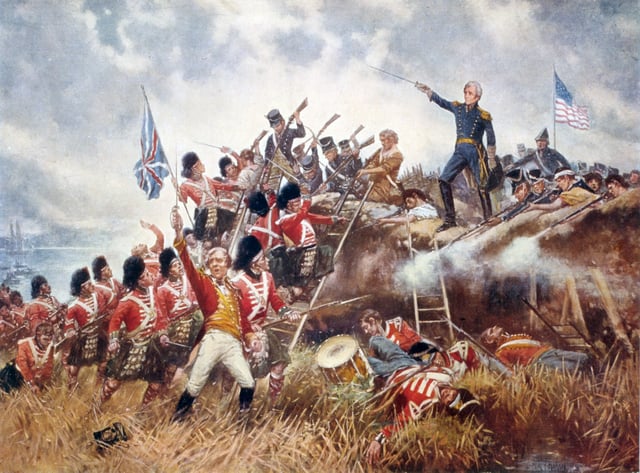
General Andrew Jackson stands on the parapet of his makeshift defenses as his troops repulse attacking Highlanders during the defense of New Orleans, the final major and most one-sided battle of the War of 1812
The War of 1812, the second and last war between the United States and Great Britain, had mixed results. The U.S. Army did not conquer Canada but it did destroy Native American resistance to expansion in the Old Northwest and it validated its independence by stopping two major British invasions in 1814 and 1815. After taking control of Lake Erie in 1813, the U.S. Army seized parts of western Upper Canada, burned York and defeated Tecumseh, which caused his Western Confederacy to collapse. Following U.S. victories in the Canadian province of Upper Canada, British troops who had dubbed the U.S. Army "Regulars, by God!", were able to capture and burn Washington, which was defended by militia, in 1814. The regular army, however proved they were professional and capable of defeating the British army during the invasions of Plattsburgh and Baltimore, prompting British agreement on the previously rejected terms of a status quo ante bellum. Two weeks after a treaty was signed (but not ratified), Andrew Jackson defeated the British in the Battle of New Orleans and Siege of Fort St. Philip, and became a national hero. U.S. troops and sailors captured HMS Cyane, Levant and Penguin in the final engagements of the war. Per the treaty, both sides (the United States and Great Britain) returned to the geographical status quo. Both navies kept the warships they had seized during the conflict.
The army's major campaign against the Indians was fought in Florida against Seminoles. It took long wars (1818–1858) to finally defeat the Seminoles and move them to Oklahoma. The usual strategy in Indian wars was to seize control of the Indians' winter food supply, but that was no use in Florida where there was no winter. The second strategy was to form alliances with other Indian tribes, but that too was useless because the Seminoles had destroyed all the other Indians when they entered Florida in the late eighteenth century.[28]
The U.S. Army fought and won the Mexican–American War (1846–1848), which was a defining event for both countries.[29] The U.S. victory resulted in acquisition of territory that eventually became all or parts of the states of California, Nevada, Utah, Colorado, Arizona, Wyoming and New Mexico.
American Civil War
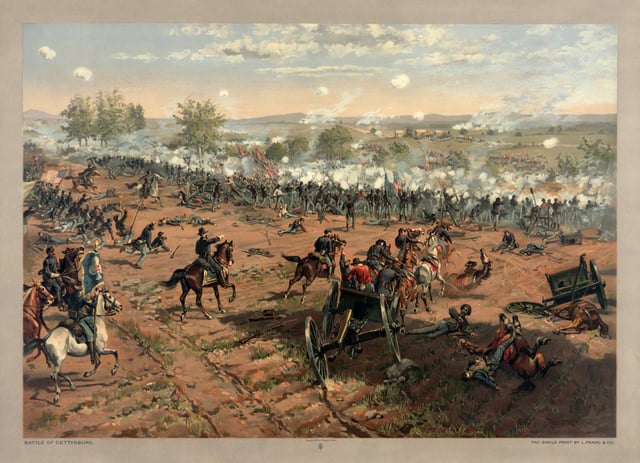
The Battle of Gettysburg, the turning point of the American Civil War
The American Civil War was the costliest war for the U.S. in terms of casualties. After most slave states, located in the southern U.S., formed the Confederate States, the Confederate States Army, led by former U.S. Army officers, mobilized a large fraction of Southern white manpower. Forces of the United States (the "Union" or "the North") formed the Union Army, consisting of a small body of regular army units and a large body of volunteer units raised from every state, north and south, except South Carolina.[30]
For the first two years Confederate forces did well in set battles but lost control of the border states.[31] The Confederates had the advantage of defending a large territory in an area where disease caused twice as many deaths as combat. The Union pursued a strategy of seizing the coastline, blockading the ports, and taking control of the river systems. By 1863, the Confederacy was being strangled. Its eastern armies fought well, but the western armies were defeated one after another until the Union forces captured New Orleans in 1862 along with the Tennessee River. In the Vicksburg Campaign of 1862–1863, General Ulysses Grant seized the Mississippi River and cut off the Southwest. Grant took command of Union forces in 1864 and after a series of battles with very heavy casualties, he had General Robert E. Lee under siege in Richmond as General William T. Sherman captured Atlanta and marched through Georgia and the Carolinas. The Confederate capital was abandoned in April 1865 and Lee subsequently surrendered his army at Appomattox Court House. All other Confederate armies surrendered within a few months.
Later 19th century
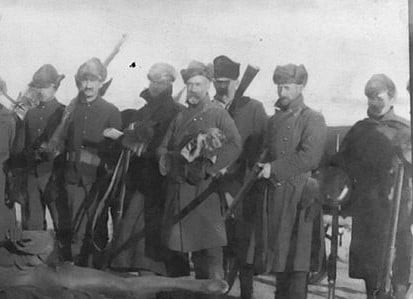
Army soldiers in 1890
Following the Civil War, the U.S. Army had the mission of containing western tribes of Native Americans on the Indian reservations. They set up many forts, and engaged in the last of the American Indian Wars. U.S. Army troops also occupied several Southern states during the Reconstruction Era to protect freedmen.
The key battles of the Spanish–American War of 1898 were fought by the Navy. Using mostly new volunteers, the U.S. Army defeated Spain in land campaigns in Cuba and played the central role in the Philippine–American War.
20th century
Starting in 1910, the army began acquiring fixed-wing aircraft.[33] In 1910, Mexico was having a civil war, peasant rebels fighting government soldiers. The army was deployed to U.S. towns near the border to ensure safety to lives and property. In 1916, Pancho Villa, a major rebel leader, attacked Columbus, New Mexico, prompting a U.S. intervention in Mexico until 7 February 1917. They fought the rebels and the Mexican federal troops until 1918.
World wars
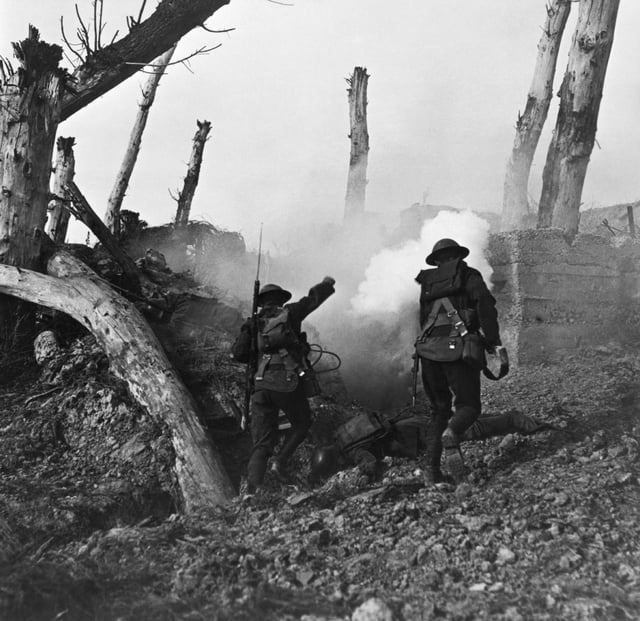
U.S. Army troops assault a German bunker, France, c. 1918
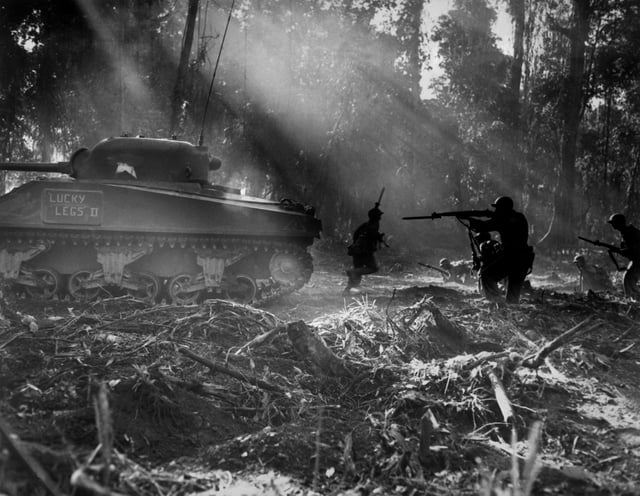
U.S. soldiers hunt Japanese infiltrators during the Bougainville Campaign
The United States joined World War I as an "Associated Power" in 1917 on the side of Britain, France, Russia, Italy and the other Allies. U.S. troops were sent to the Western Front and were involved in the last offensives that ended the war. With the armistice in November 1918, the army once again decreased its forces.
In 1939, estimates of the Army's strength range between 174,000 and 200,000 soldiers, smaller than that of Portugal's, which ranked it 17th or 19th in the world in size. General George C. Marshall became Army Chief of Staff in September 1939 and set about expanding and modernizing the Army in preparation for war.[34][35]
The United States joined World War II in December 1941 after the Japanese attack on Pearl Harbor. Some 11 million Americans were to serve in various Army operations.[36][37] On the European front, U.S. Army troops formed a significant portion of the forces that captured North Africa and Sicily and later fought in Italy. On D-Day 6 June 1944 and in the subsequent liberation of Europe and defeat of Nazi Germany, millions of U.S. Army troops played a central role.
In the Pacific War, U.S. Army soldiers participated alongside the United States Marine Corps in capturing the Pacific Islands from Japanese control. Following the Axis surrenders in May (Germany) and August (Japan) of 1945, army troops were deployed to Japan and Germany to occupy the two defeated nations. Two years after World War II, the Army Air Forces separated from the army to become the United States Air Force in September 1947. In 1948, the army was desegregated by order of President Harry S. Truman.
Cold War
1945–1960
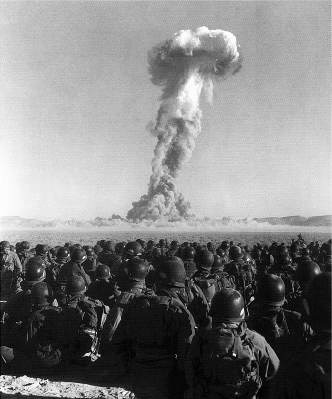
U.S. Army soldiers look on an atomic bomb test of Operation Buster-Jangle at the Nevada Test Site during the Korean War.
The end of World War II set the stage for the East–West confrontation known as the Cold War. With the outbreak of the Korean War, concerns over the defense of Western Europe rose. Two corps, V and VII, were reactivated under Seventh United States Army in 1950 and U.S. strength in Europe rose from one division to four. Hundreds of thousands of U.S. troops remained stationed in West Germany, with others in Belgium, the Netherlands and the United Kingdom, until the 1990s in anticipation of a possible Soviet attack.[38] []
During the Cold War, U.S. troops and their allies fought communist forces in Korea and Vietnam. The Korean War began in June 1950, when the Soviets walked out of a UN Security Council meeting, removing their possible veto. Under a United Nations umbrella, hundreds of thousands of U.S. troops fought to prevent the takeover of South Korea by North Korea and later to invade the northern nation. After repeated advances and retreats by both sides and the Chinese People's Volunteer Army's entry into the war, the Korean Armistice Agreement returned the peninsula to the status quo in July 1953.
1960–1970
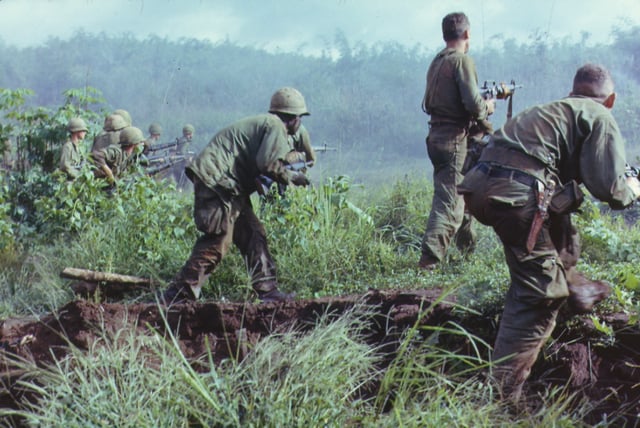
A U.S. Army infantry patrol moves up to assault the last North Vietnamese Army position at Dak To, South Vietnam during Operation Hawthorne
The Vietnam War is often regarded as a low point for the U.S. Army due to the use of drafted personnel, the unpopularity of the war with the U.S. public and frustrating restrictions placed on the military by U.S. political leaders. While U.S. forces had been stationed in South Vietnam since 1959, in intelligence and advising/training roles, they were not deployed in large numbers until 1965, after the Gulf of Tonkin Incident. U.S. forces effectively established and maintained control of the "traditional" battlefield, but they struggled to counter the guerrilla hit and run tactics of the communist Viet Cong and the North Vietnamese Army. On a tactical level, U.S. soldiers (and the U.S. military as a whole) did not lose a sizable battle.[39]
During the 1960s, the Department of Defense continued to scrutinize the reserve forces and to question the number of divisions and brigades as well as the redundancy of maintaining two reserve components, the Army National Guard and the Army Reserve.[40] In 1967, Secretary of Defense Robert McNamara decided that 15 combat divisions in the Army National Guard were unnecessary and cut the number to eight divisions (one mechanized infantry, two armored, and five infantry), but increased the number of brigades from seven to 18 (one airborne, one armored, two mechanized infantry and 14 infantry). The loss of the divisions did not sit well with the states. Their objections included the inadequate maneuver element mix for those that remained and the end to the practice of rotating divisional commands among the states that supported them. Under the proposal, the remaining division commanders were to reside in the state of the division base. However, no reduction in total Army National Guard strength was to take place, which convinced the governors to accept the plan. The states reorganized their forces accordingly between 1 December 1967 and 1 May 1968.
1970–1990

U.S. Army soldiers prepare to take La Comandancia in the El Chorrillo neighborhood of Panama City during the United States invasion of Panama
The Total Force Policy was adopted by Chief of Staff of the Army General Creighton Abrams in the aftermath of the Vietnam War and involves treating the three components of the army – the Regular Army, the Army National Guard and the Army Reserve as a single force.[41] Believing that no U.S. president should be able to take the United States (and more specifically the U.S. Army) to war without the support of the U.S. people, General Abrams intertwined the structure of the three components of the army in such a way as to make extended operations impossible, without the involvement of both the Army National Guard and the Army Reserve.[42]
The 1980s was mostly a decade of reorganization. The army converted to an all-volunteer force with greater emphasis on training and technology. The Goldwater-Nichols Act of 1986 created unified combatant commands bringing the army together with the other four military services under unified, geographically organized command structures. The army also played a role in the invasions of Grenada in 1983 (Operation Urgent Fury) and Panama in 1989 (Operation Just Cause).
By 1989 Germany was nearing reunification and the Cold War was coming to a close. Army leadership reacted by starting to plan for a reduction in strength. By November 1989 Pentagon briefers were laying out plans to reduce army end strength by 23%, from 750,000 to 580,000.[43] A number of incentives such as early retirement were used.
1990s
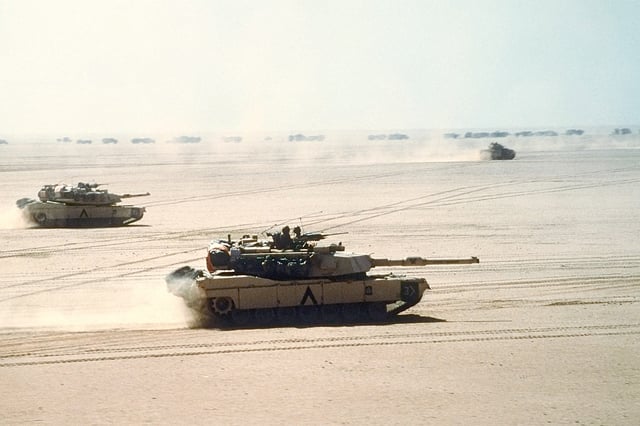
M1 Abrams move out before the Battle of Al Busayyah during the Gulf War
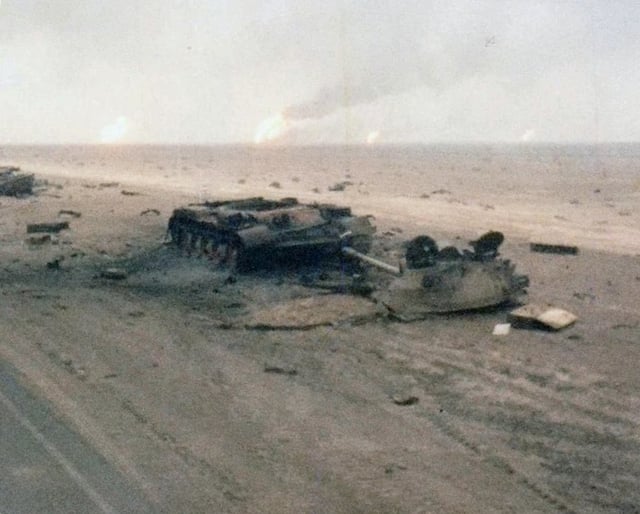
Iraqi tanks destroyed by Task Force 1-41 Infantry during the 1st Gulf War, February 1991
In 1990, Iraq invaded its smaller neighbor, Kuwait, and U.S. land forces quickly deployed to assure the protection of Saudi Arabia. In January 1991 Operation Desert Storm commenced, a U.S.-led coalition which deployed over 500,000 troops, the bulk of them from U.S. Army formations, to drive out Iraqi forces. The campaign ended in total victory, as Western coalition forces routed the Iraqi Army. Some of the largest tank battles in history were fought during the Gulf war. The Battle of Medina Ridge, Battle of Norfolk and the Battle of 73 Easting were tank battles of historical significance.[44][45][46]
After Operation Desert Storm, the army did not see major combat operations for the remainder of the 1990s but did participate in a number of peacekeeping activities. In 1990 the Department of Defense issued guidance for "rebalancing" after a review of the Total Force Policy,[47] but in 2004, Air War College scholars concluded the guidance would reverse the Total Force Policy which is an "essential ingredient to the successful application of military force".[48]
21st century
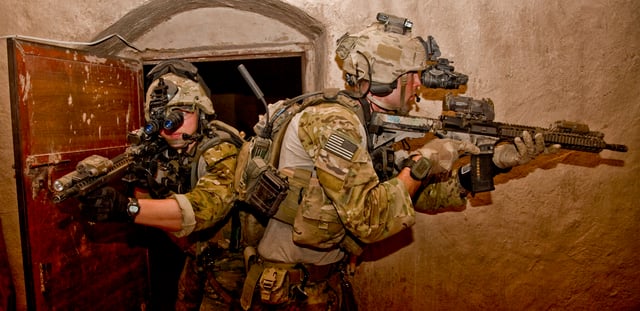
Army Rangers take part in a raid during operation in Nahr-e Saraj, Afghanistan
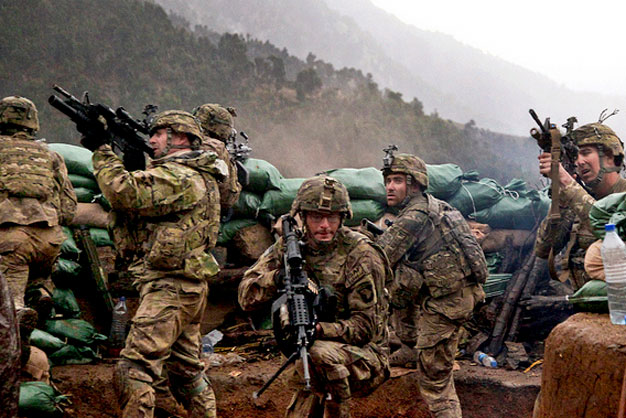
U.S. Army soldiers with 2nd Battalion, 327th Infantry Regiment, 101st Airborne Division return fire during a firefight with Taliban forces in Barawala Kalay Valley in Kunar province, Afghanistan, March 2011
On 11 September 2001, 53 Army civilians (47 employees and six contractors) and 22 soldiers were among the 125 victims killed in the Pentagon in a terrorist attack when American Airlines Flight 77 commandeered by five Al-Qaeda hijackers slammed into the western side of the building, as part of the September 11 attacks.[49] In response to the 11 September attacks and as part of the Global War on Terror, U.S. and NATO forces invaded Afghanistan in October 2001, displacing the Taliban government. The U.S. Army also led the combined U.S. and allied invasion of Iraq in 2003; it served as the primary source for ground forces with its ability to sustain short and long-term deployment operations. In the following years, the mission changed from conflict between regular militaries to counterinsurgency, resulting in the deaths of more than 4,000 U.S. service members (as of March 2008) and injuries to thousands more.[50][51] 23,813 insurgents were killed in Iraq between 2003–2011.[52]
Until 2009, the army's chief modernization plan, its most ambitious since World War II,[53] was the Future Combat Systems program. In 2009 many systems were canceled, and the remaining were swept into the BCT modernization program.[54] By 2017, the Brigade Modernization project was completed and its headquarters, the Brigade Modernization Command, was renamed the Joint Modernization Command, or JMC.[55] In response to Budget sequestration in 2013, Army plans were to shrink to 1940 levels,[56] although actual Active-Army end-strengths were projected to fall to some 450,000 troops by the end of FY2017.[57][58] From 2016 to 2017, the Army retired hundreds of OH-58 Kiowa Warrior observation helicopters,[59] while retaining its Apache gunships.[60] The 2015 expenditure for Army research, development and acquisition changed from $32 billion projected in 2012 for FY15 to $21 billion for FY15 expected in 2014.[61]
Organization
Planning
"Plans are of little importance, but planning is essential." –Winston Churchill[62]
By 2017, a task force was formed to address Army modernization,[63] which triggered shifts of units: RDECOM, and ARCIC, from within Army Materiel Command (AMC), and TRADOC, respectively, to a new Army Command (ACOM) in 2018.[64] The Army Futures Command (AFC), is a peer of FORSCOM, TRADOC, and AMC, the other ACOMs.[65] AFC's mission is modernization reform: to design hardware, as well as to work within the acquisition process which defines materiel for AMC. TRADOC's mission is to define the architecture and organization of the Army, and to train and supply soldiers to FORSCOM.[66] [] [38] AFC's cross-functional teams (CFTs) are Futures Command's vehicle for sustainable reform of the acquisition process for the future.[67] In order to support the Army's modernization priorities, its FY2020 budget allocated $30 billion for the top six modernization priorities over the next five years.[68] The $30 billion came from $8 billion in cost avoidance and $22 billion in terminations.[68]
Army components
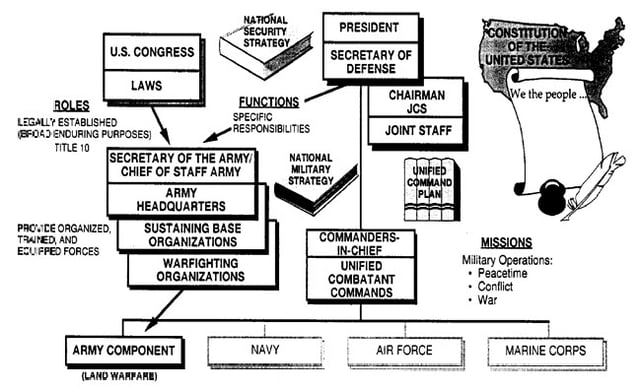
U.S. Army organization chart[69]
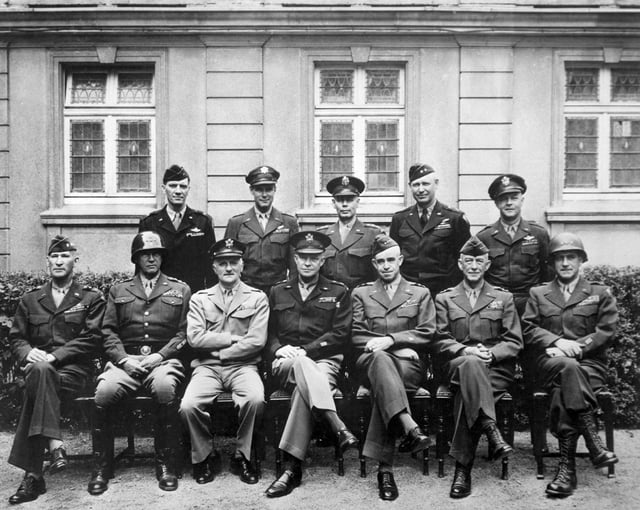
U.S. general officers, World War II, Europe
The task of organizing the U.S. Army commenced in 1775.[70] In the first one hundred years of its existence, the United States Army was maintained as a small peacetime force to man permanent forts and perform other non-wartime duties such as engineering and construction works. During times of war, the U.S. Army was augmented by the much larger United States Volunteers which were raised independently by various state governments. States also maintained full-time militias which could also be called into the service of the army.
By the twentieth century, the U.S. Army had mobilized the U.S. Volunteers on four separate occasions during each of the major wars of the nineteenth century. During World War I, the "National Army" was organized to fight the conflict, replacing the concept of U.S. Volunteers.[71] It was demobilized at the end of World War I, and was replaced by the Regular Army, the Organized Reserve Corps and the State Militias. In the 1920s and 1930s, the "career" soldiers were known as the "Regular Army" with the "Enlisted Reserve Corps" and "Officer Reserve Corps" augmented to fill vacancies when needed.[72]
In 1941, the "Army of the United States" was founded to fight World War II. The Regular Army, Army of the United States, the National Guard and Officer/Enlisted Reserve Corps (ORC and ERC) existed simultaneously. After World War II, the ORC and ERC were combined into the United States Army Reserve. The Army of the United States was re-established for the Korean War and Vietnam War and was demobilized upon the suspension of the draft.[72]
Currently, the Army is divided into the Regular Army, the Army Reserve and the Army National Guard.[71] Some states further maintain state defense forces, as a type of reserve to the National Guard, while all states maintain regulations for state militias.[73] State militias are both "organized", meaning that they are armed forces usually part of the state defense forces, or "unorganized" simply meaning that all able bodied males may be eligible to be called into military service.
The U.S. Army is also divided into several branches and functional areas. Branches include officers, warrant officers, and enlisted Soldiers while functional areas consist of officers who are reclassified from their former branch into a functional area. However, officers continue to wear the branch insignia of their former branch in most cases, as functional areas do not generally have discrete insignia. Some branches, such as Special Forces, operate similarly to functional areas in that individuals may not join their ranks until having served in another Army branch. Careers in the Army can extend into cross-functional areas for officer,[74] warrant officer, enlisted, and civilian personnel.
| Branch | Insignia | Branch | Insignia | Functional Area (FA) | ||
|---|---|---|---|---|---|---|
| Acquisition Corps (AC) | Air Defense Artillery (AD) |  | Information Network Engineering (FA 26) | |||
| Adjutant General's Corps (AG) Includes Army Bands (AB) | Armor (AR) Includes Cavalry (CV) | Information Operations (FA 30) | ||||
| Aviation (AV) | Civil Affairs Corps (CA) | Strategic Intelligence (FA 34) | ||||
| Chaplain Corps (CH) | Chemical Corps (CM) | Space Operations (FA 40) | ||||
| Cyber Corps (CY) | Dental Corps (DC) |  | Public Affairs Officer (FA 46) | |||
| Corps of Engineers (EN) | Field Artillery (FA) | Academy Professor (FA 47) | ||||
| Finance Corps (FI) | Infantry (IN) | Foreign Area Officer (FA 48) | ||||
| Judge Advocate General's Corps (JA) | Logistics (LG) |  | Operations Research/Systems Analysis (FA 49) | |||
| Medical Corps (MC) |  | Military Intelligence Corps (MI) | Force Management (FA 50) | |||
| Military Police Corps (MP) | Medical Service Corps (MS) |  | Acquisition (FA 51)[74] | |||
| Medical Specialist Corps (SP) |  | Army Nurse Corps (AN) |  | Simulation Operations (FA 57) | ||
| Ordnance Corps (OD) | Psychological Operations (PO) | Health Services (FA 70) | ||||
| Public Affairs (PA) | Quartermaster Corps (QM) | Laboratory Sciences (FA 71) | ||||
| Signal Corps (SC) | Special Forces (SF) | Preventive Medicine Sciences (FA 72) | ||||
| Transportation Corps (TC) |  | Veterinary Corps (VC) |  | Behavioral Sciences (FA 73) |
Before 1933, members of the Army National Guard were considered state militia until they were mobilized into U.S. Army, typically on the onset of war. Since the 1933 amendment to the National Defense Act of 1916, all Army National Guard soldiers have held dual status. They serve as National Guardsmen under the authority of the governor of their state or territory and as a reserve members of the U.S. Army under the authority of the president, in the Army National Guard of the United States.
Since the adoption of the total force policy, in the aftermath of the Vietnam War, reserve component soldiers have taken a more active role in U.S. military operations. For example, Reserve and Guard units took part in the Gulf War, peacekeeping in Kosovo, Afghanistan and the 2003 invasion of Iraq.
Army commands and army service component commands
[[INLINE_IMAGE|//upload.wikimedia.org/wikipedia/commons/thumb/4/43/Headquarters_US_Army_SSI.png/25px-Headquarters_US_Army_SSI.png|//upload.wikimedia.org/wikipedia/commons/thumb/4/43/Headquarters_US_Army_SSI.png/38px-Headquarters_US_Army_SSI.png 1.5x, //upload.wikimedia.org/wikipedia/commons/thumb/4/43/Headquarters_US_Army_SSI.png/50px-Headquarters_US_Army_SSI.png 2x|Headquarters US Army SSI.png|h33|w25]] Headquarters, United States Department of the Army (HQDA):
| Army Commands | Current commander | Location of headquarters |
|---|---|---|
| GEN Michael X. Garrett | Fort Bragg, North Carolina | |
| GEN John M. Murray | Austin, Texas | |
| GEN Gustave F. Perna | Redstone Arsenal, Alabama | |
| GEN Paul E. Funk II | Fort Eustis, Virginia | |
| Army Service Component Commands | Current commander | Location of headquarters |
| MG Roger L. Cloutier, Jr.[75] | Caserma Ederle, Vicenza, Italy | |
| LTG Terry Ferrell | Shaw Air Force Base, South Carolina | |
| LTG Christopher Cavoli[76] | Clay Kaserne, Wiesbaden, Germany | |
| LTG Laura J. Richardson | Joint Base San Antonio, Texas | |
| GEN Robert B. Brown | Fort Shafter, Hawaii | |
| MG Clarence K.K. Chinn | Joint Base San Antonio, Texas | |
| LTG Stephen G. Fogarty | Fort Belvoir, Virginia[80] | |
| LTG James H. Dickinson | Redstone Arsenal, Alabama | |
| LTG Francis M. Beaudette | Fort Bragg, North Carolina | |
| Operational Force Headquarters | Current commander | Location of headquarters |
| LTG Thomas S. Vandal[82] | Camp Humphreys, South Korea | |
| Direct reporting units | Current commander | Location of headquarters |
| Katharine Kelley[84](civilian) | Arlington, Virginia | |
| Craig A. Spisak[86](civilian) | Fort Belvoir, Virginia | |
| BG Larry D. Gottardi[88][89] | Washington, D.C. | |
| LTG Todd T. Semonite[90] | Washington, D.C. | |
| MG David P. Glaser | Quantico, Virginia | |
| BG David C. Coburn | Indianapolis, Indiana[91] | |
| MG Jason T. Evans | Alexandria, Virginia | |
| MG Christopher S. Ballard | Fort Belvoir, Virginia | |
| LTG Nadja West | Joint Base San Antonio, Texas | |
| MG Michael L. Howard | Fort Lesley J. McNair, Washington, D.C. | |
| MG Frank M. Muth[94] | Fort Knox, Kentucky | |
| MG Joel K. Tyler[95] | Alexandria, Virginia | |
| MG John S. Kem | Carlisle, Pennsylvania | |
| LTG Darryl A. Williams | West Point, New York |
Source: U.S. Army organization[97]
Structure

U.S. Army soldiers of 1st Battalion, 175th Infantry Regiment, Maryland Army National Guard conduct an urban cordon and search exercise as part of the army readiness and training evaluation program in the mock city of Balad at Fort Dix, New Jersey
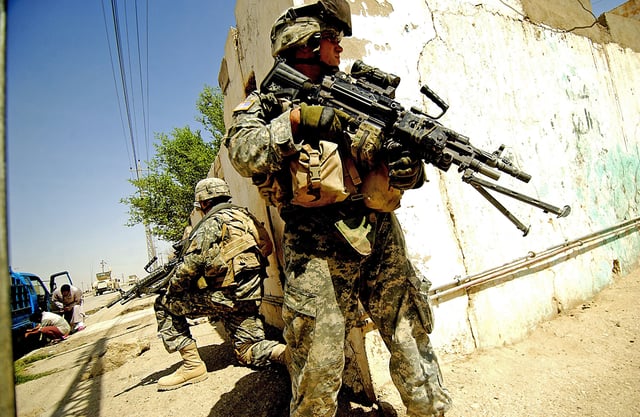
U.S. soldiers from the 6th Infantry Regiment taking up positions on a street corner during a foot patrol in Ramadi, Iraq
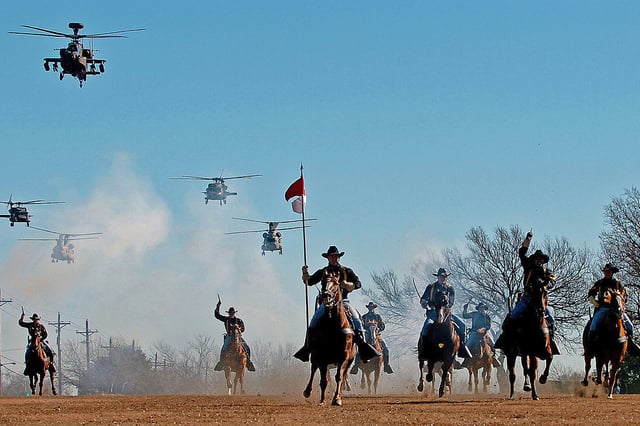
The 1st Cavalry Division's combat aviation brigade performs a mock charge with the horse detachment
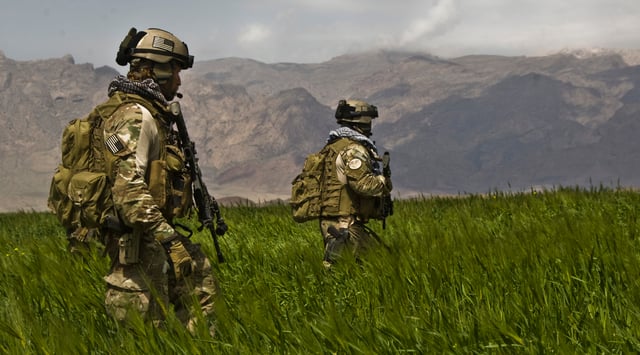
U.S. Army Special Forces soldiers from the 3rd Special Forces Group patrol a field in the Gulistan district of Farah, Afghanistan
See Structure of the United States Army for detailed treatment of the history, components, administrative and operational structure and the branches and functional areas of the Army.
The U.S. Army is made up of three components: the active component, the Regular Army; and two reserve components, the Army National Guard and the Army Reserve. Both reserve components are primarily composed of part-time soldiers who train once a month – known as battle assemblies or unit training assemblies (UTAs) – and conduct two to three weeks of annual training each year. Both the Regular Army and the Army Reserve are organized under Title 10 of the United States Code, while the National Guard is organized under Title 32. While the Army National Guard is organized, trained and equipped as a component of the U.S. Army, when it is not in federal service it is under the command of individual state and territorial governors. However, the District of Columbia National Guard reports to the U.S. president, not the district's mayor, even when not federalized. Any or all of the National Guard can be federalized by presidential order and against the governor's wishes.[98]
The U.S. Army is led by a civilian secretary of the Army, who has the statutory authority to conduct all the affairs of the army under the authority, direction and control of the secretary of defense.[99] The chief of staff of the Army, who is the highest-ranked military officer in the army, serves as the principal military adviser and executive agent for the Secretary of the Army, i.e., its service chief; and as a member of the Joint Chiefs of Staff, a body composed of the service chiefs from each of the four military services belonging to the Department of Defense who advise the president of the United States, the secretary of defense and the National Security Council on operational military matters, under the guidance of the chairman and vice chairman of the Joint Chiefs of Staff.[100][101] In 1986, the Goldwater–Nichols Act mandated that operational control of the services follows a chain of command from the president to the secretary of defense directly to the unified combatant commanders, who have control of all armed forces units in their geographic or function area of responsibility, thus the secretaries of the military departments (and their respective service chiefs underneath them) only have the responsibility to organize, train and equip their service components. The army provides trained forces to the combatant commanders for use as directed by the secretary of defense.[102]
By 2013, the army shifted to six geographical commands that align with the six geographical unified combatant commands (COCOM):
United States Army Central headquartered at Shaw Air Force Base, South Carolina
United States Army North headquartered at Fort Sam Houston, Texas
United States Army South headquartered at Fort Sam Houston, Texas
United States Army Europe headquartered at Clay Kaserne, Wiesbaden, Germany
United States Army Pacific headquartered at Fort Shafter, Hawaii
United States Army Africa headquartered at Vicenza, Italy
The army also transformed its base unit from divisions to brigades. Division lineage will be retained, but the divisional headquarters will be able to command any brigade, not just brigades that carry their divisional lineage. The central part of this plan is that each brigade will be modular, i.e., all brigades of the same type will be exactly the same and thus any brigade can be commanded by any division. As specified before the 2013 end-strength re-definitions, the three major types of ground combat brigades are:
Armored brigades, with strength of 4,743 troops as of 2014.
Stryker brigades, with strength of 4,500 troops as of 2014.
Infantry brigades, with strength of 4,413 troops as of 2014.
In addition, there are combat support and service support modular brigades. Combat support brigades include aviation (CAB) brigades, which will come in heavy and light varieties, fires (artillery) brigades (now transforms to division artillery) and expeditionary military intelligence brigades. Combat service support brigades include sustainment brigades and come in several varieties and serve the standard support role in an army.
Combat maneuver organizations
- *To track the effects of the 2018 budget cuts, seeTransformation of the United States Army#Divisions and brigades
The U.S. Army currently consists of 10 active divisions and one deployable division headquarters (7th Infantry Division) as well as several independent units. The force is in the process of contracting after several years of growth. In June 2013, the Army announced plans to downsize to 32 active combat brigade teams by 2015 to match a reduction in active duty strength to 490,000 soldiers. Army Chief of Staff Raymond Odierno projected that the Army was to shrink to "450,000 in the active component, 335,000 in the National Guard and 195,000 in U.S. Army Reserve" by 2018.[103] However, this plan was scrapped by the new administration and now the Army plans to grow by 16,000 soldiers to a total of 476,000 by October 2017. The National Guard and the Army Reserve will see a smaller expansion.[104][105]
Within the Army National Guard and United States Army Reserve there are a further 8 divisions, over 15 maneuver brigades, additional combat support and combat service support brigades and independent cavalry, infantry, artillery, aviation, engineer and support battalions. The Army Reserve in particular provides virtually all psychological operations and civil affairs units.
[[INLINE_IMAGE|//upload.wikimedia.org/wikipedia/commons/thumb/0/03/United_States_Army_Forces_Command_SSI.svg/25px-United_States_Army_Forces_Command_SSI.svg.png|//upload.wikimedia.org/wikipedia/commons/thumb/0/03/United_States_Army_Forces_Command_SSI.svg/38px-United_States_Army_Forces_Command_SSI.svg.png 1.5x, //upload.wikimedia.org/wikipedia/commons/thumb/0/03/United_States_Army_Forces_Command_SSI.svg/50px-United_States_Army_Forces_Command_SSI.svg.png 2x|United States Army Forces Command SSI.svg|h25|w25]] United States Army Forces Command (FORSCOM)
| Direct reporting units | Current commander | Location of headquarters |
|---|---|---|
| LTG Gary J. Volesky | Joint Base Lewis-McChord, Washington | |
| LTG Paul E. Funk II | Fort Hood, Texas | |
| LTG Paul LaCamera | Fort Bragg, North Carolina | |
| LTG Thomas S. James Jr. | Rock Island Arsenal, Illinois | |
| LTG Charles D. Luckey | Fort Bragg, North Carolina |
| Combat maneuver units aligned under FORSCOM | |||
|---|---|---|---|
| Name | Headquarters | Subunits | Subordinate to |
| 1st Armored Division | Fort Bliss, Texas and New Mexico | 3 armored BCTs (ABCTs),[108] 1 Division Artillery (DIVARTY), 1 Combat Aviation Brigade (CAB) and 1 sustainment brigade | III Corps |
| 1st Cavalry Division | Fort Hood, Texas | 3 armored BCTs, 1 DIVARTY, 1 CAB and 1 sustainment brigade | III Corps |
| Fort Riley, Kansas | 2 armored BCTs, 1 DIVARTY, 1 CAB and 1 sustainment brigade | III Corps | |
| 3rd Cavalry Regiment | Fort Hood, Texas | 4 Stryker squadrons, 1 fires squadron, 1 engineer squadron and 1 support squadron (overseen by the 1st Cavalry Division)[109] | III Corps |
| 3rd Infantry Division | Fort Stewart, Georgia | 2 armored BCT, 1 DIVARTY, 1 CAB and 1 sustainment brigade as well as the 48th Infantry Brigade Combat Team of the Georgia Army National Guard | XVIII Airborne Corps |
| 4th Infantry Division | Fort Carson, Colorado | 1 infantry BCT, 1 Stryker BCT, 1 armored BCT, DIVARTY, 1 CAB and 1 sustainment brigade | III Corps |
| 7th Infantry Division | Joint Base Lewis-McChord, Washington | Administrative control of 2 Stryker BCTs and 1 DIVARTY of the 2nd Infantry Division as well as the 81st Stryker Brigade Combat Team of the Washington and California Army National Guard | I Corps |
| 10th Mountain Division | Fort Drum, New York | 2 infantry BCTs, 1 DIVARTY, 1 CAB and 1 sustainment brigade as well as the 86th Infantry Brigade Combat Team (Mountain) of the Vermont Army National Guard | XVIII Airborne Corps |
| 82nd Airborne Division | Fort Bragg, North Carolina | 3 airborne infantry BCTs, 1 airborne DIVARTY, 1 CAB and 1 airborne sustainment brigade | XVIII Airborne Corps |
| 101st Airborne Division | Fort Campbell, Kentucky | 3 air assault infantry BCTs, 1 air assault DIVARTY, 1 CAB and 1 air assault sustainment brigade | XVIII Airborne Corps |
| Combat maneuver units aligned under other organizations | |||
|---|---|---|---|
| Name | Headquarters | Subunits | Subordinate to |
| 2nd Cavalry Regiment | Rose Barracks, Vilseck, Germany | 4 Stryker squadrons, 1 engineer squadron, 1 fires squadron and 1 support squadron | U.S. Army Europe |
| 2nd Infantry Division | Camp Humphreys, South Korea | 2 Stryker BCTs, 1 mechanized brigade from the ROK Army,[110] 1 DIVARTY (under administrative control of 7th ID), 1 sustainment brigade, and a stateside ABCT from another active division that is rotated in on a regular basis | Eighth Army |
| 25th Infantry Division | Schofield Barracks, Hawaii | 2 infantry BCTs (including the 100th Infantry Battalion, 442nd Infantry Regiment of the Army Reserve), 1 airborne infantry BCT, 1 Stryker BCT, 1 DIVARTY, 1 CAB, and 1 sustainment brigade | U.S. Army Pacific |
| 173rd Airborne Brigade Combat Team | Camp Ederle, Vicenza, Italy | 3 airborne infantry battalions (including 1st Battalion, 143rd Infantry Regiment of the Texas Army National Guard), 1 airborne field artillery battalion, 1 cavalry squadron, 1 airborne engineer battalion,[111] and 1 airborne support battalion | U.S. Army Europe |
| Name | Locations | Subunits |
|---|---|---|
| 28th Infantry Division | Pennsylvania, Ohio and Maryland | 2nd Infantry BCT, 56th Stryker BCT and 28th CAB |
| 29th Infantry Division | Virginia, Maryland, North Carolina and Florida | |
| 34th Infantry Division | Minnesota, Wisconsin, Iowa and Idaho | 1st Armored BCT, 2nd Infantry BCT, |
| 35th Infantry Division | Kansas, Missouri, Illinois, Oklahoma, Georgia and Arkansas | |
| 36th Infantry Division | Texas, Louisiana and Mississippi | 56th Infantry BCT, 72nd Infantry BCT, |
| 38th Infantry Division | Indiana, Michigan, Ohio and Tennessee | |
| 40th Infantry Division | California, Oregon, Washington and Hawaii | |
| 42nd Infantry Division | New York, New Jersey and Vermont | |
For a description of U.S. Army tactical organizational structure, see: a U.S. context and also a global context.
Special operations forces
[[INLINE_IMAGE|//upload.wikimedia.org/wikipedia/commons/thumb/4/47/U.S.Army_Special_Operations_Command_SSI%281989-2015%29.svg/25px-U.S.Army_Special_Operations_Command_SSI%281989-2015%29.svg.png|//upload.wikimedia.org/wikipedia/commons/thumb/4/47/U.S.Army_Special_Operations_Command_SSI%281989-2015%29.svg/38px-U.S.Army_Special_Operations_Command_SSI%281989-2015%29.svg.png 1.5x, //upload.wikimedia.org/wikipedia/commons/thumb/4/47/U.S.Army_Special_Operations_Command_SSI%281989-2015%29.svg/50px-U.S.Army_Special_Operations_Command_SSI%281989-2015%29.svg.png 2x|U.S. Army Special Operations Command SSI (1989-2015).svg|h42|w25]] United States Army Special Operations Command (Airborne) (USASOC):[112]
| Name | Headquarters | Structure and purpose |
|---|---|---|
| 1st Special Forces Command (Airborne) | Fort Bragg, North Carolina | The 1st Special Forces Command (Airborne) [1st SFC(A)] manages seven special forces groups (SFG) [the 1st SFG(A), 3rd SFG(A), 5th SFG(A), 7th SFG(A), 10th SFG(A), 19th SFG(A) (ARNG) and 20th SFG(A) (ARNG)] designed to deploy and execute nine doctrinal missions: unconventional warfare, foreign internal defense, direct action, counter-insurgency, special reconnaissance, counter-terrorism, information operations, counterproliferation of weapon of mass destruction, and security force assistance. The command also manages two psychological operations groups [the 4th POG(A) and 8th POG(A)] tasked to work with foreign nations to induce or reinforce behavior favorable to U.S. objectives; the 95th Civil Affairs Brigade (Airborne) that enables military commanders and U.S. ambassadors to improve relationships with various stakeholders via five battalions; and the 528th Sustainment Brigade (Special Operations) (Airborne) that provides combat service support and combat health support units via two battalions, various support/liaison elements, and Medical Role II teams. The command also has an organic 389th Military Intelligence Battalion (Airborne)[113] providing multi-source intelligence information and analysis. |
| Army Special Operations Aviation Command | Ft. Bragg, North Carolina | Organizes, mans, trains, resources and equips Army special operations aviation units to provide responsive, special operations aviation support to Special Operations Forces (SOF) consisting of five units: USASOC Flight Company (UFC), Special Operations Training Battalion (SOATB), Technology Applications Program Office (TAPO), Systems Integration Management Office (SIMO) and the 160th Special Operations Aviation Regiment (Airborne). |
| 75th Ranger Regiment | Fort Benning, Georgia | Three maneuver battalions and a special troops battalion of elite airborne infantry specializing in large-scale, joint forcible entry operations while simultaneously executing precision targeting operations raids across the globe. Additional capabilities include air assault and direct action raids seizing key terrain such as airfields, destroying strategic facilities, and capturing or killing the enemies of the Nation. The Regiment also helps develop the equipment, technologies, training, and readiness that bridge the gap between special operations and traditional combat maneuver organizations. |
| John F. Kennedy Special Warfare Center and School | Ft. Bragg, North Carolina | The SWCS selects and trains special forces, civil affairs, and psychological operations soldiers consisting of five distinct units and the Directorate of Training and Doctrine: 1st Special Warfare Training Group (Airborne), Special Warfare Education Group (Airborne), Special Warfare Medical Group (Airborne), Special Forces Warrant Officer Institute, and David K. Thuma Non-Commissioned Officers Academy. |
| 1st Special Forces Operational Detachment-Delta | Ft. Bragg, North Carolina | Commonly referred to as Delta Force, Combat Applications Group (CAG), "The Unit," Army Compartmented Element (ACE), or Task Force Green is an elite special operations unit—under the control of Joint Special Operations Command, a component command of |
Personnel
These are the U.S. Army ranks authorized for use today and their equivalent NATO designations. Although no living officer currently holds the rank of General of the Army, it is still authorized by Congress for use in wartime.
Commissioned officers
There are several paths to becoming a commissioned officer[116] including the United States Military Academy, Reserve Officers' Training Corps and Officer Candidate School. Regardless of which road an officer takes, the insignia are the same. Certain professions including physicians, pharmacists, nurses, lawyers and chaplains are commissioned directly into the army and are designated by insignia unique to their staff community.
Most army commissioned officers are promoted based on an "up or out" system. The Defense Officer Personnel Management Act of 1980 establishes rules for timing of promotions and limits the number of officers that can serve at any given time.
Army regulations call for addressing all personnel with the rank of general as "General (last name)" regardless of the number of stars. Likewise, both colonels and lieutenant colonels are addressed as "Colonel (last name)" and first and second lieutenants as "Lieutenant (last name)".[117]
| U.S. DoD Pay Grade | O-1 | O-2 | O-3 | O-4 | O-5 | O-6 | O-7 | O-8 | O-9 | O-10 | O-11 | |
|---|---|---|---|---|---|---|---|---|---|---|---|---|
| Insignia |  |  |  |  | ||||||||
| Title | Second Lieutenant | First Lieutenant | Captain | Major | Lieutenant Colonel | Colonel | Brigadier General | Major General | Lieutenant General | General | General of the Army | |
| Abbreviation | 2LT | 1LT | CPT | MAJ | LTC | COL | BG | MG | LTG | GEN | GA | |
| NATO Code | OF-1 | OF-2 | OF-3 | OF-4 | OF-5 | OF-6 | OF-7 | OF-8 | OF-9 | OF-10 | ||
| Note: General of the Army is reserved for wartime.[118] | ||||||||||||
Warrant officers
Warrant officers[116] are single track, specialty officers with subject matter expertise in a particular area. They are initially appointed as warrant officers (in the rank of WO1) by the secretary of the Army, but receive their commission upon promotion to chief warrant officer two (CW2).
By regulation, warrant officers are addressed as "Mr. (last name)" or "Ms. (last name)" by senior officers and as "sir" or "ma'am" by all enlisted personnel.[117] However, many personnel address warrant officers as "Chief (last name)" within their units regardless of rank.
Enlisted personnel
Privates, privates second class and privates first class (E3) are addressed as "Private (last name)", specialists as "Specialist (last name)", corporals as "Corporal (last name)" and sergeants, staff sergeants, sergeants first class and master sergeants all as "Sergeant (last name)". First sergeants are addressed as "First Sergeant (last name)" and sergeants major and command sergeants major are addressed as "Sergeant Major (last name)".[117]
| U.S. DoD Pay grade | E-1 | E-2 | E-3 | E-4 | E-5 | E-6 | E-7 | E-8 | E-9 | ||||
|---|---|---|---|---|---|---|---|---|---|---|---|---|---|
| Insignia | No insignia | ||||||||||||
| Title | Private | Private
Second Class [120] | Private First Class | Specialist | Corporal | Sergeant | Staff Sergeant | Sergeant First Class | Master Sergeant | First Sergeant | Sergeant Major | Command Sergeant Major | Sergeant Major of the Army |
| Abbreviation | PV1 ¹ | PV2 ¹ | PFC | SPC ² | CPL | SGT | SSG | SFC | MSG | 1SG | SGM | CSM | SMA |
| NATO Code | OR-1 | OR-2 | OR-3 | OR-4 | OR-4 | OR-5 | OR-6 | OR-7 | OR-8 | OR-8 | OR-9 | OR-9 | OR-9 |
| ¹ PVT is also used as an abbreviation for both private ranks when pay grade need not be distinguished.[121] ² SP4 is sometimes encountered instead of SPC for specialist. This is a holdover from when there were additional specialist ranks at pay grades E-5 to E-7. | |||||||||||||
Training
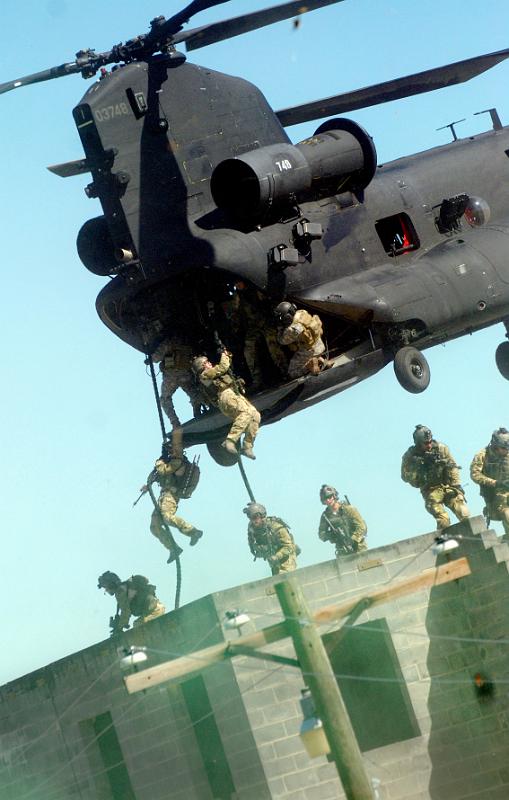
Rangers practice fast roping techniques from an MH-47 during an exercise at Fort Bragg
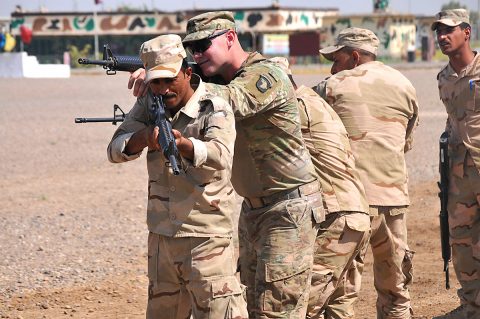
A trainer with Company A, 1st Battalion 502nd Infantry Regiment, Task Force Strike, 101st Airborne Division assists Iraqi army ranger students during a room clearing drill at Camp Taji, Iraq on 18 July 2016
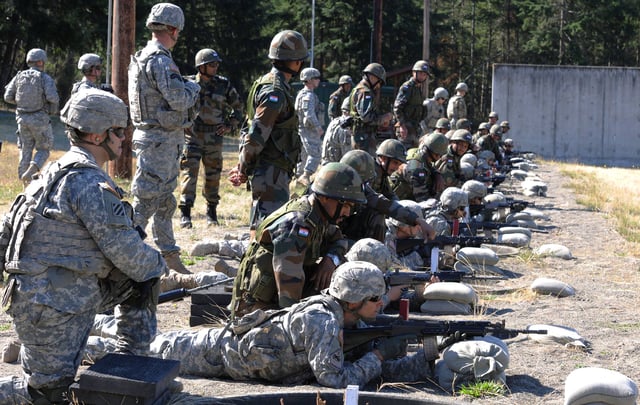
U.S. Army soldiers familiarizing with the latest INSAS 1B1 during exercise Yudh Abhyas 2015
Training in the U.S. Army is generally divided into two categories – individual and collective. Basic training consists of 10 weeks "this does not include processing & out-processing" most recruits followed by Advanced Individualized Training (AIT) where they receive training for their military occupational specialties (MOS). Some individual's MOSs range anywhere from 14–20 weeks of One Station Unit Training (OSUT), which combines Basic Training and AIT. The length of AIT school varies by the MOS. The length of time spent in AIT depends on the MOS of the soldier and some highly technical MOS training may require many months (e.g., foreign language translators). Depending on the needs of the army, Basic Combat Training for combat arms soldiers is conducted at a number of locations, but two of the longest-running are the Armor School and the Infantry School, both at Fort Benning, Georgia. Sergeant Major of the Army Dailey notes that an infantrymen's pilot program for One Station Unit Training (OSUT) extends 8 weeks beyond Basic Training and AIT, to 22 weeks. The pilot, designed to boost infantry readiness, is due to end in December 2018. The new Infantry OSUT covered the M240 machine gun as well as the M249 squad automatic weapon.[122] The redesigned Infantry OSUT would start in 2019.[123][124] Depending on the result of the 2018 pilot, OSUTs could also extend training in other combat arms beyond the infantry.[123] One Station Unit Training will be extended to 22 weeks for Armor by Fiscal Year 2021.[22] Additional OSUTs are expanding to Cavalry, Engineer, and Military Police (MP) in the succeeding Fiscal Years.[125]
A new training assignment for junior officers is being instituted, that they serve as platoon leaders for Basic Combat Training (BCT) platoons.[126] These lieutenants will assume many of the administrative, logistical, and day-to-day tasks formerly performed by the drill sergeants of those platoons and are expected to "lead, train, and assist with maintaining and enhancing the morale, welfare and readiness" of the drill sergeants and their BCT platoons.[126] These lieutenants are also expected to stem any inappropriate behaviors they witness in their platoons, to free up the drill sergeants for training.[126]
The United States Army Combat Fitness Test (ACFT) is being introduced into the Army, beginning with 60 battalions spread throughout the Army.[127] The test is the same for all soldiers, men or women. It will take an hour to complete, including resting periods.[128] The ACFT supersedes the Army physical fitness test (APFT),[129][130] as being more relevant to survival in combat.[127] Six events were determined to better predict which muscle groups of the body were adequately conditioned for combat actions:[128] three deadlifts,[131] a standing power throw of a ten-pound medicine ball,[132] hand-release pushups[133] (which replace the traditional pushup), a sprint/drag/carry 250 yard event,[134] three pull-ups with leg tucks (one needed to pass),[135] a mandatory rest period, and a two-mile run.[136] Eventually (by October 2020) all soldiers from all three components (Active Army, Reserve, and National guard)[137] will be subject to this test.[138][139] The ACFT will test all soldiers in basic training by October 2020. The ACFT movements directly translate to movements on the battlefield.[124]
Following their basic and advanced training at the individual-level, soldiers may choose to continue their training and apply for an "additional skill identifier" (ASI). The ASI allows the army to take a wide-ranging MOS and focus it into a more specific MOS. For example, a combat medic, whose duties are to provide pre-hospital emergency treatment, may receive ASI training to become a cardiovascular specialist, a dialysis specialist or even a licensed practical nurse. For commissioned officers, training includes pre-commissioning training, known as Basic Officer Leader Course A, either at USMA or via ROTC, or by completing OCS. After commissioning, officers undergo branch specific training at the Basic Officer Leaders Course B, (formerly called Officer Basic Course), which varies in time and location according to their future assignments. Officers will continue to attend standardized training at different stages of their career.[140]
Collective training at the unit level takes place at the unit's assigned station, but the most intensive training at higher echelons is conducted at the three combat training centers (CTC); the National Training Center (NTC) at Fort Irwin, California, the Joint Readiness Training Center (JRTC) at Fort Polk, Louisiana and the Joint Multinational Training Center (JMRC) at the Hohenfels Training Area in Hohenfels and Grafenwöhr,[141] Germany. ARFORGEN is the Army Force Generation process approved in 2006 to meet the need to continuously replenish forces for deployment, at unit level and for other echelons as required by the mission. Individual-level replenishment still requires training at a unit level, which is conducted at the continental U.S. (CONUS) replacement center (CRC) at Fort Bliss, in New Mexico and Texas before their individual deployment.[142]
Chief of Staff Milley notes that the Army is suboptimized for training in cold-weather regions, jungles, mountains, or urban areas where in contrast the Army does well when training for deserts or rolling terrain.[143] [] Post 9/11, Army unit-level training was for counter-insurgency (COIN); by 2014–2017, training had shifted to decisive action training.[144]
Equipment
The chief of staff of the Army has identified six modernization priorities, in order: artillery, ground vehicles, aircraft, network, air/missile defense, and soldier lethality.[145]
Weapons
Individual weapons
The army employs various individual weapons to provide light firepower at short ranges. The most common weapon type used by the army is the M4 carbine, a compact variant of the M16 rifle,[146] along with the 7.62×51mm variant of the FN SCAR for Army Rangers. The primary sidearm in the U.S. Army is the 9 mm M9 pistol; the M11 pistol is also used. Both handguns are to be replaced by the M17[147] through the Modular Handgun System program.[148] Soldiers are also equipped with various hand grenades, such as the M67 fragmentation grenade and M18 smoke grenade.
Many units are supplemented with a variety of specialized weapons, including the M249 SAW (Squad Automatic Weapon), to provide suppressive fire at the squad level.[149] Indirect fire is provided by the M320 grenade launcher. The M1014 Joint Service Combat Shotgun or the Mossberg 590 Shotgun are used for door breaching and close-quarters combat. The M14EBR is used by designated marksmen. Snipers use the M107 Long Range Sniper Rifle, the M2010 Enhanced Sniper Rifle and the M110 Semi-Automatic Sniper Rifle.
Crew-served weapons
The army employs various crew-served weapons to provide heavy firepower at ranges exceeding that of individual weapons.
The U.S. Army uses three types of mortar for indirect fire support when heavier artillery may not be appropriate or available. The smallest of these is the 60 mm M224, normally assigned at the infantry company level.[152] At the next higher echelon, infantry battalions are typically supported by a section of 81 mm M252 mortars.[153] The largest mortar in the army's inventory is the 120 mm M120/M121, usually employed by mechanized units.[154]
The U.S. Army utilizes a variety of direct-fire rockets and missiles to provide infantry with an Anti-Armor Capability. The AT4 is an unguided projectile that can destroy armor and bunkers at ranges up to 500 meters. The FIM-92 Stinger is a shoulder-launched, heat seeking anti-aircraft missile. The FGM-148 Javelin and BGM-71 TOW are anti-tank guided missiles.
Vehicles
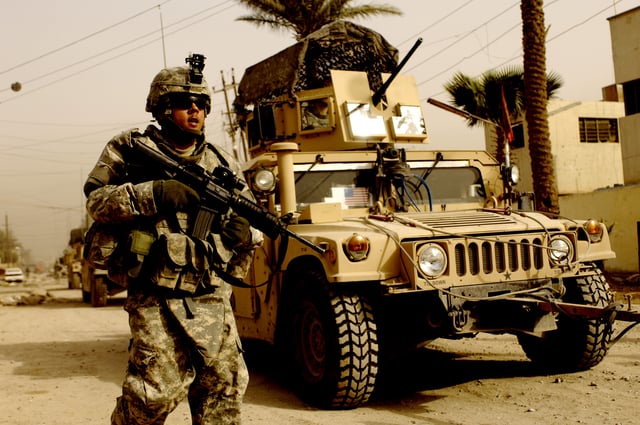
A U.S. soldier on patrol with the support of a Humvee vehicle

3rd Infantry Division soldiers manning an M1A1 Abrams in Iraq
U.S. Army doctrine puts a premium on mechanized warfare. It fields the highest vehicle-to-soldier ratio in the world as of 2009.[157] The army's most common vehicle is the High Mobility Multipurpose Wheeled Vehicle (HMMWV), commonly called the Humvee, which is capable of serving as a cargo/troop carrier, weapons platform and ambulance, among many other roles.[158] While they operate a wide variety of combat support vehicles, one of the most common types centers on the family of HEMTT vehicles. The M1A2 Abrams is the army's main battle tank,[159] while the M2A3 Bradley is the standard infantry fighting vehicle.[160] Other vehicles include the Stryker,[161] the M113 armored personnel carrier[162] and multiple types of Mine Resistant Ambush Protected (MRAP) vehicles.
While the United States Army Aviation Branch operates a few fixed-wing aircraft, it mainly operates several types of rotary-wing aircraft. These include the AH-64 Apache attack helicopter,[165] the UH-60 Black Hawk utility tactical transport helicopter[166] and the CH-47 Chinook heavy-lift transport helicopter.[167] Restructuring plans call for reduction of 750 aircraft and from 7 to 4 types.[168]
Under the Johnson-McConnell agreement of 1966, the Army agreed to limit its fixed-wing aviation role to administrative mission support (light unarmed aircraft which cannot operate from forward positions). For UAVs, the Army is deploying at least one company of drone MQ-1C Gray Eagles to each Active Army division.[169]
Uniforms
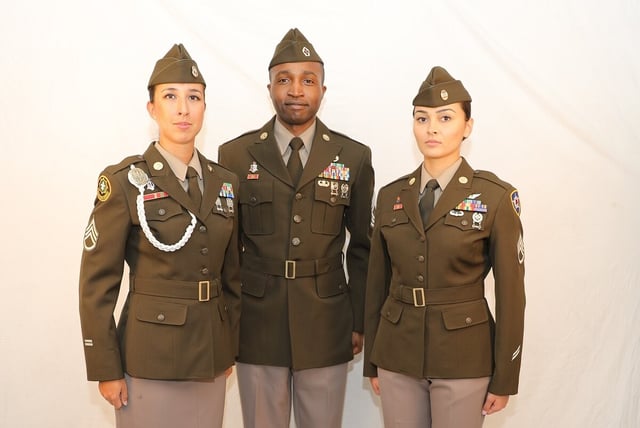
The 2020 Army Greens uniform
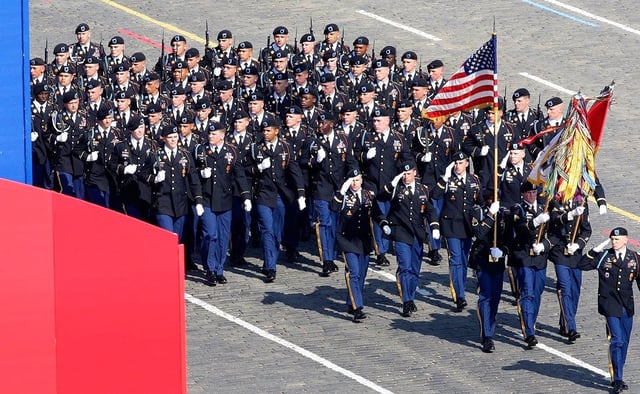
An element of the 18th Infantry Regiment, wearing ASUs, representing the United States at the 2010 Victory Day commemoration in Moscow
The Army Combat Uniform (ACU) currently features a camouflage pattern known as Operational Camouflage Pattern (OCP). This replaced a pixelated pattern known as Universal Camouflage Pattern (UCP) that proved to be ineffective in many environments.
On 11 November 2018, the Army announced a new version of 'Army Greens' based on uniforms worn during World War II will become the standard garrison service uniform.[170] The blue Army Service Uniform will remain as the dress uniform. The Army Greens are projected to be first fielded in summer of 2020.[170]
Berets
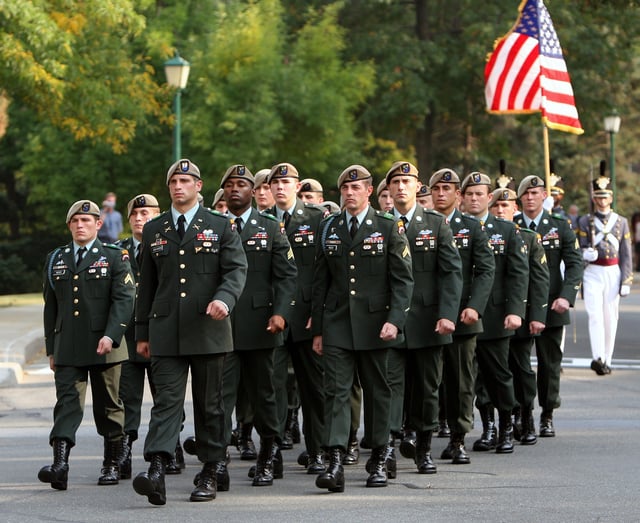
The Ranger Honor Platoon marching in their tan berets and former service uniform
The beret flash of enlisted personnel displays their distinctive unit insignia (shown above). The U.S. Army's black beret is no longer worn with the ACU for garrison duty, having been permanently replaced with the patrol cap. After years of complaints that it was not suited well for most work conditions, Army Chief of Staff General Martin Dempsey eliminated it for wear with the ACU in June 2011. Soldiers still wear berets who are currently in a unit in jump status, whether the wearer is parachute-qualified or not (maroon beret), while members of Security Force Assistance Brigades (SFABs) wear brown berets. Members of the 75th Ranger Regiment and the Airborne and Ranger Training Brigade (tan beret) and Special Forces (rifle green beret) may wear it with the Army Service Uniform for non-ceremonial functions. Unit commanders may still direct the wear of patrol caps in these units in training environments or motor pools.
Tents
The Army has relied heavily on tents to provide the various facilities needed while on deployment (Force Provider Expeditionary (FPE) ).[145] [] The most common tent uses for the military are as temporary barracks (sleeping quarters), DFAC buildings (dining facilities),[171] forward operating bases (FOBs), after action review (AAR), tactical operations center (TOC), morale, welfare and recreation (MWR) facilities, as well as security checkpoints. Furthermore, most of these tents are set up and operated through the support of Natick Soldier Systems Center. Each FPE contains billeting, latrines, showers, laundry and kitchen facilities for 50–150 Soldiers,[145] [] and is stored in Army Prepositioned Stocks 1, 2, 4 and 5. This provisioning allows combatant commanders to position soldiers as required in their Area of Responsibility, within 24 to 48 hours.
The U.S. Army is beginning to use a more modern tent called the deployable rapid assembly shelter (DRASH). In 2008, DRASH became part of the Army's Standard Integrated Command Post System.[172]
See also
America's Army (Video games for recruitment)
Army CHESS (Computer Hardware Enterprise Software and Solutions)
Comparative military ranks
History of the United States Army
List of active United States military aircraft
List of former United States Army medical units
List of wars involving the United States
Officer Candidate School (United States Army)
Reserve Officers' Training Corps and Junior Reserve Officers' Training Corps
Soldier's Creed
Structure of the United States Army
Timeline of United States military operations
Transformation of the United States Army
U.S. Army Combat Arms Regimental System
U.S. Army Regimental System
United States Army Basic Training
United States Army Center of Military History
United States Volunteers
Vehicle markings of the United States military
Warrant Officer Candidate School (United States Army)








